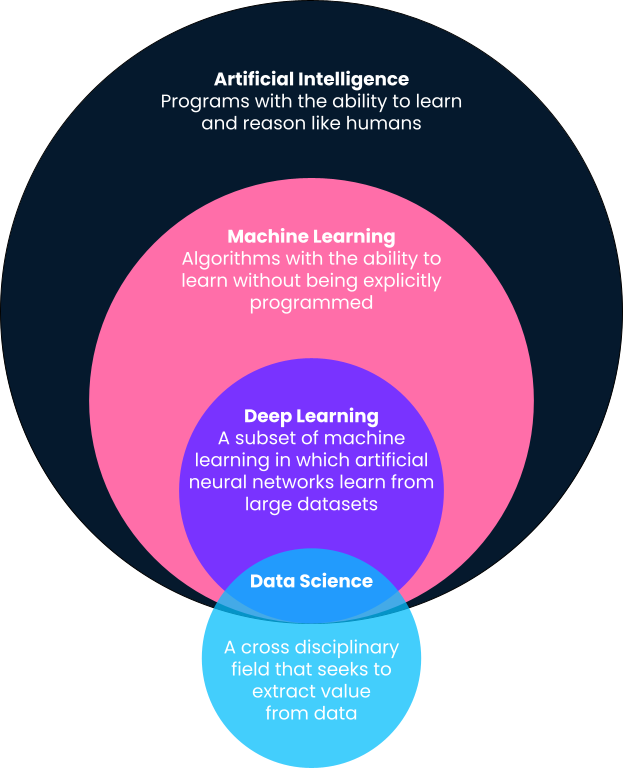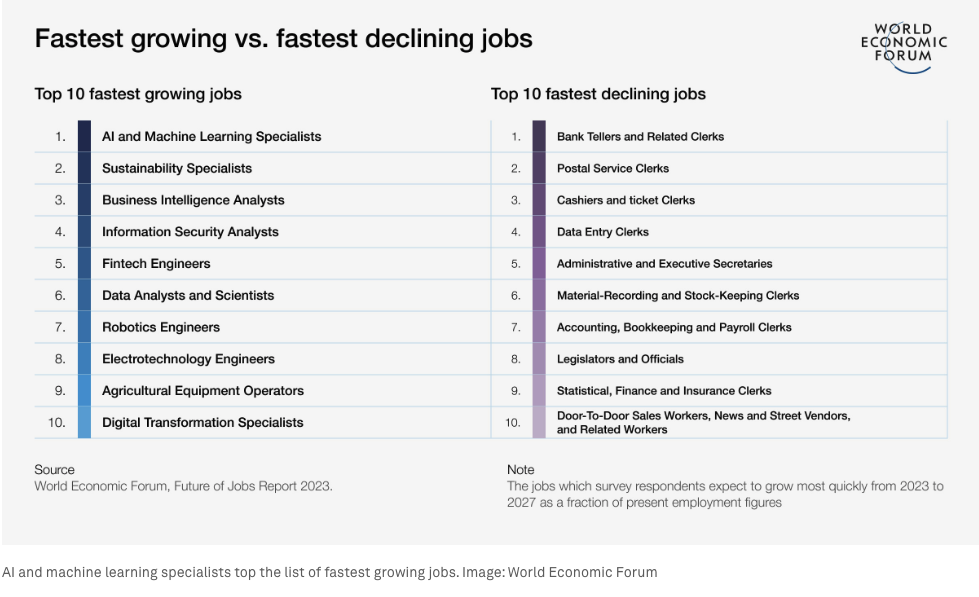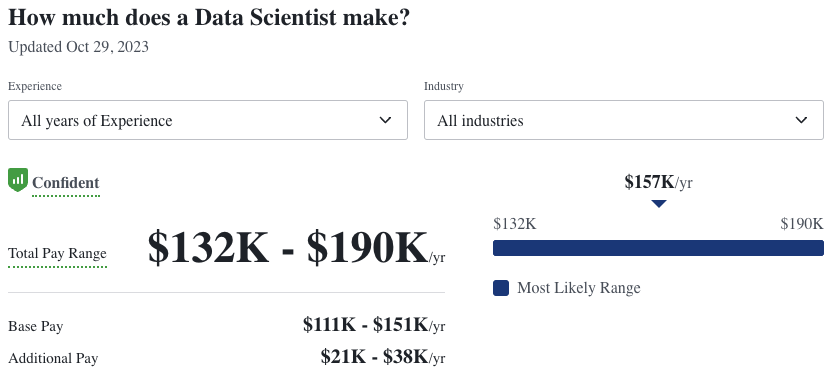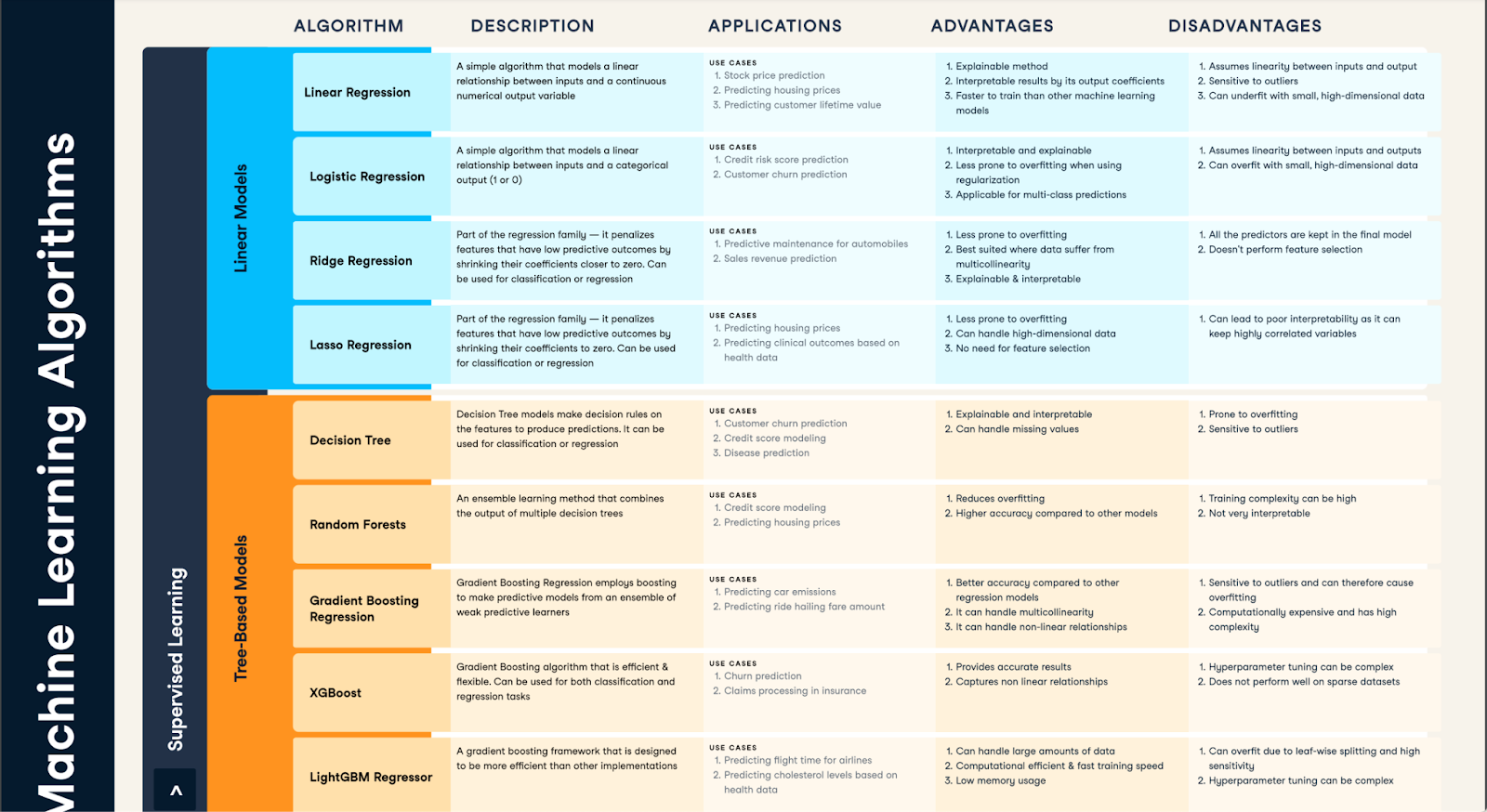course
How to Learn Machine Learning in 2024
In a world increasingly driven by data and automation, machine learning stands out as a highly rewarding and lucrative career path. Demand for machine learning skills has skyrocketed, with The World Economic Forum forecasting that demand for AI and machine learning specialists will increase 40% from 2023 to 2027. This surge underscores the relevance and urgency for professionals and enthusiasts alike to dive into the realms of ML.
This article will outline how to get started with machine learning—from key skills and technologies you need to learn to a dedicated machine learning study plan and certifications you can take.
What is Machine Learning?
We’ve got a full article dedicated to exploring what machine learning is. However, at its core, machine learning (ML) is a branch of artificial intelligence (AI) focused on building systems that learn from data.
By identifying patterns in vast datasets, ML algorithms can make predictions or decisions without being explicitly programmed to perform specific tasks. This capability distinguishes ML from traditional software, where outcomes are predetermined by a set of rules. Common machine-learning applications include self-driving cars, automated credit scoring, and even generative AI tools like ChatGPT.
The differences between artificial intelligence, machine learning & deep learning
The world of data & AI is full of terms and acronyms, and if you’ve paid attention to this space, you may see words like “Artificial intelligence,” “Machine Learning,” and “Deep Learning” being used interchangeably. It’s worth defining these terms in more detail before we discuss how to approach your ML learning journey. We’ve got a full article exploring the differences between AI, ML, and DL, but to summarise:
- Artificial Intelligence represents a broader concept of machines capable of performing tasks in a way that we would consider "smart." In this context, a simple calculator can be seen as a form of AI. You can also read our guide on how to learn AI to discover more.
- Machine Learning, a subset of AI, involves algorithms enabling computers to learn from and make data-based decisions. A good example here is clustering customers based on their purchasing behaviors.
- Deep Learning, further narrowing down, is a subset of ML that uses neural networks with many layers (hence "deep") to analyze patterns in data, mimicking the human brain's approach to learning. Deep learning is responsible for the awe-inspiring results coming from AI in popular media. ChatGPT and self-driving cars are examples of deep learning in action.

The difference between supervised learning and unsupervised learning
As you dive deeper into machine learning, other terms you may hear are “Supervised learning” and “Unsupervised learning” — these refer to different paradigms within machine learning and deep learning. Let’s unpack them below:
- Supervised learning: A paradigm in machine learning in which algorithms learn the relationships between input data and outcomes we aim to model, where the algorithm is able to predict outcomes based on new input data. A good example here would be a credit scoring model algorithm, which, when trained on the financial data of clients who defaulted on their credit, could better predict who is likely to default in the future.
- Unsupervised learning: A paradigm in machine learning in which algorithms learn similarities between input data and group them accordingly. A good example here is customer segmentation algorithms that cluster customers based on their purchasing and demographic characteristics.
Why Learn Machine Learning in 2024?
Machine learning is a growing field
According to The World Economic Forum, the demand for AI and machine learning specialists will increase by 40% from 2023 to 2027. This comes as no surprise as the exponential growth in data generation and the need for data-driven decision-making in industries across the board have propelled the demand for machine learning expertise.
The job market for machine learning professionals has seen substantial growth, reflecting the increasing adoption of machine learning technologies in various sectors.

AI and Machine Learning are the fastest-growing jobs - Image source
Machine learning is a high-paying job
With increased demand and scarce talent comes increased compensation. Positions in machine learning are among the highest-paying in the tech industry. Data from platforms like Glassdoor highlight the lucrative salaries commanded by roles such as Data Scientists, AI Engineers, and Machine Learning Engineers, making it an attractive career path for many.
Here are salaries for common titles in this space with figures from Glassdoor
- Data Scientist: $132K - $190K
- Machine Learning Engineer: $126K - $187K
- AI Engineer: $125K - $194K
- Research Scientist: $116K - $176K

Image source
Machine learning is intellectually challenging
There is a reason why machine learning talent is scarce at the moment, it’s not an easy skill to pick up. Outside of the financial incentives, machine learning presents a rich landscape of intellectual challenges. The field's dynamic nature, requiring constant learning and adaptation to new technologies and methodologies, makes it an exciting area for problem solvers and those passionate about pushing the boundaries of what machines can do.
How Long Does it Take to Learn Machine Learning?
The journey to mastering machine learning varies greatly depending on your approach. For self-learners, the timeframe can vary widely based on existing knowledge, commitment level, and resources at your disposal.
It might take from a few months to over a year to develop a robust grasp of ML principles, programming (notably Python), mathematics, and a variety of algorithms, with self-directed online courses, tutorials, and hands-on projects potentially speeding up the process.
Opting for formal education, such as a university degree in computer science, data science, or a related area, typically involves a three to four-year commitment. These programs offer in-depth training in machine learning alongside related subjects. Regardless of the path chosen, the key to success in machine learning lies in ongoing learning, practical application, and staying abreast of the latest field developments.
What’s important to note is that machine learning is a career of lifelong learning, as new technologies and methodologies are constantly being developed.
How to Learn Machine Learning From Scratch in 2024
Diving into machine learning is an exciting journey with complexities. It's a vast domain spanning many subdomains. But with a clear plan, appropriate resources, and a methodical approach, the path becomes manageable. Here's your guide to navigating the awesome world of machine learning in 2024:
1. Brush up on the prerequisites
Before embarking on your machine learning journey, it's essential to build a solid foundation in key areas. These fundamental skills are the pillars of your artificial intelligence knowledge and abilities::
- Basic mathematics. Machine learning is deeply rooted in mathematical principles. While you don't need to be a math wizard to excel in machine learning, grasping the basics of linear algebra, calculus, and statistics is crucial. For example, understanding matrix operations and linear transformations in linear algebra is vital for navigating through machine learning and deep learning algorithms.
- Basic statistics. Grasping the principles of statistics enhances your comprehension of machine learning. The ability to analyze data and extract meaningful insights is indispensable in this domain. Familiarity with concepts such as statistical significance, distributions, regression analysis, and probability estimates is key to applying various machine learning techniques effectively.
- A willingness to learn. Machine learning is an ever-evolving discipline, characterized by constant innovations, methodologies, and technologies. Thus, having a forward-thinking attitude and a zeal for continuous learning and adaptation is essential for anyone aspiring to make their mark or progress in the machine learning field.
It's worth mentioning that the level of expertise and proficiency needed in these foundational domains varies based on the specific machine learning role you're targeting. For example, a data scientist may not require an exhaustive knowledge of every mathematical principle applied in machine learning, whereas a research scientist focused on developing new machine learning models might need a deeper mathematical understanding.
Ultimately, tailoring your learning trajectory to your career objectives and modulating the intensity of your studies across different subjects is crucial.
2. Start developing your machine learning skills
Machine learning is a broad field encompassing various subskills, each critical to mastering the domain. Here, we'll break down these skills and provide resources to deepen your understanding.
Statistics
Statistics is crucial in machine learning for analyzing data, making predictions, and drawing conclusions. It encompasses understanding data distributions, statistical tests, and probability theories, which are foundational in building and evaluating machine learning models. Here are some resources that can get you started with statistics for machine learning:
- Statistics Fundamentals with Python Skill Track
- Introduction to Statistics Course
- Data Demystified: An Overview of Descriptive Statistics
Mathematics
Mathematics, especially linear algebra, calculus, and probability, is essential for understanding the underlying principles of machine learning algorithms. These mathematical concepts are directly applied in various ML techniques, from optimizing algorithms to understanding the structure of neural networks.
Programming
Programming is the tool that brings machine learning models to life. Python is the most prevalent language due to its simplicity and the extensive libraries available for data science and machine learning, such as NumPy, Pandas, and Scikit-learn. However, there are also many practitioners who use R for machine learning. In a section below, we will share top machine learning tools & packages in both of these languages.
- Python Programming Skill Track
- R Programming Skill Track
- Introduction to Programming Paradigms Course
Data Structures
Data structures are essential for efficiently storing, accessing, and manipulating data in machine learning. A solid grasp of arrays, lists, trees, and graphs, along with their algorithms, can significantly optimize the performance of ML models.
- Introduction to Data Structures and Algorithms Course
- Python Data Structures with Primitive & Non-Primitive Examples Tutorial
Data Manipulation
Data manipulation involves cleaning, transforming, and preparing data for analysis. This skill is vital for machine learning, as the quality and format of data directly impact the performance of models.
- Data Manipulation with Python Skill Track
- Data Manipulation in SQL Course
- Data Manipulation with R Skill Track
Machine Learning
Understanding machine learning principles, algorithms, and applications is central to the field. This encompasses supervised and unsupervised learning, model evaluation, and tuning.
- Machine Learning Scientist with Python Career Track
- Machine Learning Fundamentals with Python Skill Track
- Machine Learning Scientist with R Skill Track
Deep learning
Deep learning, a subset of machine learning, involves training deep neural networks. This skill is particularly relevant for complex tasks like image and speech recognition, natural language processing, and more.
- Introduction to Deep Learning in Python Course
- Introduction to Deep Learning with Keras Course
- Introduction to Deep Learning in PyTorch Course
Software engineering
Software engineering skills are indispensable, especially when it comes to deploying machine learning models in a production environment. This includes understanding version control systems like Git, continuous integration and delivery (CI/CD) practices, containerization technologies such as Docker, and orchestration tools like Kubernetes. Familiarity with cloud services (AWS, GCP, Azure) for deploying and scaling applications and knowledge of APIs and web services is also crucial for integrating ML models into existing software systems.
Business Acumen
A big pitfall machine learning practitioners face today is developing models that end up never being used in production. Understanding the business implications of machine learning solutions is crucial for delivering value. This involves grasping how ML can solve real-world business problems, improve efficiencies, and drive innovation.
3. Learn essential machine learning tools & packages
Mastering machine learning requires familiarity with a range of tools and packages that facilitate data processing, model building, and algorithm implementation. While Python is definitely the most popular programming language for machine learning, we explore the most pivotal packages within the Python and R ecosystems, each serving distinct purposes in the ML workflow.
Top Python Machine Learning Packages
Pandas
Pandas is a cornerstone for data manipulation and analysis in Python, offering robust data structures like DataFrames, making it easier to clean, filter, and aggregate large datasets, which is a preliminary step in any machine learning project.
- Data Manipulation with pandas Course
- Python pandas tutorial: The ultimate guide for beginners
- Pandas Cheat Sheet for Data Science in Python
Numpy
Numpy provides the foundational array structure and mathematical functions essential for scientific computing in Python. Its efficiency in numerical calculations makes it indispensable for processing the multi-dimensional data used in machine learning algorithms.
- Introduction to NumPy Course
- NumPy Crash Course Code-Along
- NumPy Cheat Sheet: Data Analysis in Python
Scikit-learn
Scikit-Learn is a versatile tool that simplifies common machine learning tasks, including classification, regression, clustering, and dimensionality reduction, with a design that integrates seamlessly with other Python libraries like Numpy and Pandas.
- Machine Learning with scikit-learn Course
- Python Machine Learning: Scikit-Learn Tutorial
- Scikit-Learn Cheat Sheet: Python Machine Learning
XGBoost
XGBoost is renowned for its performance and speed in machine learning competitions. It's an implementation of gradient-boosted decision trees designed for speed and performance, which is crucial for many machine learning tasks.
Tensorflow
Tensorflow is a powerful library for numerical computation and machine learning that enables developers to create sophisticated deep learning models. Its flexibility and scalability make it suitable for both research and production.
- Introduction to TensorFlow in Python Course
- TensorFlow Tutorial For Beginners
- Python Convolutional Neural Networks (CNN) with TensorFlow Tutorial
Keras
Keras is designed to enable fast experimentation with deep neural networks, providing a high-level, user-friendly API that can run atop TensorFlow, allowing for easy model design and experimentation.
- Introduction to Deep Learning with Keras Course
- Advanced Deep Learning with Keras Course
- Keras Tutorial: Deep Learning in Python
PyTorch
PyTorch is celebrated for its dynamic computational graph and user-friendly interface, making it a preferred choice for researchers and developers working on cutting-edge machine learning models, especially in the realm of deep learning.
- Introduction to Deep Learning in PyTorch Course
- Intermediate Deep Learning with PyTorch Course
- PyTorch Tutorial: Building a Simple Neural Network From Scratch
- Deep Learning with PyTorch Cheat Sheet
Top R Machine Learning Packages
Tidymodels
Tidymodels is a collection of R packages for modeling and machine learning that share common principles and are designed to work together seamlessly. It simplifies many of the common tasks in a machine learning workflow, from data preprocessing to model tuning and validation.
- Modeling with tidymodels in R Course
- Feature Engineering for Predicting Hotel Bookings with tidymodels
- Analyzing Credit Scores with tidymodels in R
Caret
The Caret package in R is a comprehensive solution for building and evaluating machine learning models. It provides a unified interface to hundreds of ML algorithms, making it easier to train models, make predictions, and evaluate their performance, all within a consistent framework.
randomForest
This package implements the random forest algorithm, known for its accuracy and robustness, especially in classification and regression tasks.
XGBoost
XGBoost in R offers an efficient and scalable implementation of gradient boosting frameworks, known for delivering high performance and speed in machine learning competitions and real-world applications.
Tensorflow
Tensorflow for R enables users to leverage the powerful deep learning functionalities of TensorFlow directly within R, allowing for the development of sophisticated models with the familiarity of R's interface.
Keras
Keras in R brings the simplicity and flexibility of the Keras API to R users, making deep learning more accessible and easier to implement with high-level neural networks abstractions.
An Example of a Machine Learning Learning Plan
This ML learning plan is tailored as a foundational path, adaptable based on personal goals and roles within the field. Make sure to take advantage of it and adjust it as you see fit!
Month 1-3: Building machine learning foundations
- Strengthen math and statistics knowledge: Essential for understanding algorithms and data analysis. Linear algebra, calculus, and probability form the backbone of ML models.
- Learn programming fundamentals: Python is recommended due to its extensive support and libraries for ML. Programming skills are crucial for implementing and testing ML algorithms.
- Start working with data: Familiarize yourself with data manipulation and visualization techniques. Understanding and preprocessing data are key steps before applying any ML model.
Recommended resources
- Statistics Fundamentals with Python Skill Track
- Python Programming Skill Track
- Data Visualization with Python Skill Track
- 60+ Python Projects for All Levels of Expertise
Month 4-6: Diving into Machine Learning
- Grasp basic machine learning concepts: Differentiate between supervised and unsupervised learning. This distinction is vital for choosing the right approach for different problems.
- Construct and assess simple models: Begin with models like linear regression and decision trees to understand model-building and evaluation processes.
- Apply knowledge on real datasets: Practical experience solidifies theoretical knowledge and enhances problem-solving skills.
Recommended resources
- Machine Learning Scientist with Python Career Track
- Machine Learning Fundamentals with Python Skill Track
- Introduction to Regression with statsmodels in Python Course
- 25 Machine Learning Projects for All Levels
Month 7-9: Deepen Your Knowledge
- Delve into deep learning: Explore the complexities of neural networks, which are powerful tools for tasks like image and speech recognition.
- Understand MLOps: Learning to deploy models in production efficiently is critical for real-world applications.
- Engage in projects or competitions: Challenges help improve skills and offer insights into practical ML applications and community best practices.
Recommended resources
- Introduction to Deep Learning in Python Course
- MLOps Fundamentals
- Machine Learning, Pipelines, Deployment and MLOps Tutorial
- Machine Learning Cheat Sheet
Months 10+: Keep learning and specialize
- Select a specialization: Focusing on an area like NLP or computer vision allows for deeper expertise and understanding.
- Participate in open-source projects: Collaboration and contribution to projects can offer real-world experience and community engagement.
- Keep up with current research: Staying informed about new developments ensures your skills remain relevant and cutting-edge.
Recommended resources
Top 5 Tips for Learning Machine Learning
1. Pick a discipline
Machine learning is a vast field with numerous specializations. Begin by pinpointing areas that resonate with your interests and career aspirations. Whether it's developing algorithms, working on neural networks, or applying ML to specific industries like healthcare or finance, having a clear focus will streamline your learning journey. Tailoring your path not only makes learning more manageable but also ensures you develop expertise in areas that matter most to you.
2. Begin learning
Start your learning journey with foundational courses that cover essential principles of machine learning, statistics, and programming. Use online platforms, university courses, and workshops to build a strong base. As you progress, delve into more advanced topics and technologies. A structured approach, combining theoretical knowledge with practical insights, is key to mastering the complexities of machine learning.
3. Test your skills with projects
Theory is crucial, but nothing beats hands-on experience. Start with small projects to apply what you've learned, then gradually take on more complex challenges. Projects reinforce your knowledge and showcase your skills to potential employers. They provide tangible evidence of your capabilities and your ability to solve real-world problems with machine learning solutions.
4. Sign up to a community
The machine learning community is vast and incredibly supportive. Join forums, meetups, and hackathons to connect with peers and experts. These communities offer invaluable resources, mentorship, and project collaboration opportunities. Engaging with the community accelerates learning, keeps you motivated, and opens up new personal and professional growth opportunities.
5. Keep updated
Machine learning is an ever-evolving field, so continuous learning is crucial. Stay updated with the latest research, tools, and best practices. Experiment with new techniques, solicit feedback, and learn from failures. Iteration is a core principle of machine learning itself, and applying this mindset to your learning process will greatly enhance your skills and adaptability in this dynamic field.
The Best Resources to Learn Machine Learning in 2024
There are many resources available to help you learn machine learning, from structured courses and textbooks to hands-on projects. Choosing the right resource can help you get off to a strong start with your studies. Here are our top picks to get you started on your machine learning journey:
Take the top machine courses to get started
DataCamp is a great platform that offers interactive courses specifically tailored for aspiring data scientists. The courses range from beginner to advanced levels and are designed with hands-on exercises. Here are some of the best machine learning-related courses on DataCamp:
- Python Fundamentals
- Data Manipulation with Python
- Machine Learning Fundamentals with Python
- Machine Learning Scientist with Python
- Introduction to Deep Learning with PyTorch
Complete machine learning projects
Learning machine learning goes beyond understanding theories and coding techniques. It involves hands-on practice, and this is where completing projects comes in.
Start by identifying a suitable project based on your proficiency level and look at the right tools, such as Python and its extensive libraries, for your projects. Understanding and preparing your data is crucial, as it directly impacts your model's effectiveness.
Below are some ideas for AI projects you can build to help you on your way to AI mastery. Be sure to check out our articles on machine learning projects for all levels for further info.
- The Predict Taxi Fares project, you will be predicting the location and time to earn the biggest fare using the New York taxi dataset. You use tidyverse for data processing and visualization. To predict location and time, you will experiment with a tree base model such as Decision Tree and Random Forest.
- In the Give Life: Predict Blood Donations project, you will predict whether or not a donor will give blood in a given time window. In this project, you are processing raw data and feeding it to TPOT Python AutoML(Automated Machine Learning) tool.
- In the Find Movie Similarity from Plot Summaries project, you will use various NLP (Natural Language Processing) and KMeans to predict the similarity between movies based on the plot from IMDB and Wikipedia. You will learn to combine the data, perform Tokenization and stemming on text, transform it using TfidfVectorizer, create clusters using the KMeans algorithm, and finally plot the dendrogram.
Read some of the best machine learning books
Books offer in-depth knowledge and insights from experts in the field. Here are some of the most influential books on AI that you might find helpful:
Remember, the key to learning machine learning is consistency and practice. Don't be afraid to start small and gradually work your way up to more complex concepts and projects. You'll be amazed at how much you can learn by dedicating just a little time each day to studying.
Check out the best machine learning cheat sheets
Our selection of data science cheat sheets can act as a quick reference guide on a wide variety of machine learning topics:
- Machine Learning Cheat Sheet
- Python cheat sheet for beginners
- Supervised Machine Learning Cheat Sheet
- Unsupervised Machine Learning Cheat Sheet
- ChatGPT Cheat Sheet for Data Science
- Deep Learning with PyTorch Cheat Sheet

Our machine learning cheat sheet covers man of the algoriths and their uses
The Different Careers in Machine Learning Today
Machine learning skills are increasingly in demand across various roles. Here are four key positions where these skills are particularly valued:
Data Scientist
Data Scientists delve deep into organizational data to extract meaningful insights, communicating these findings to non-technical stakeholders. They're adept in machine learning workflows, linking them to business applications, and predominantly work with coding tools for analysis, often engaging with big data tools.
Their role involves sifting through data, managing large datasets, and integrating various data points to discern trends. By employing analytical, statistical, and programming skills, they analyze and interpret large datasets to craft data-driven solutions for complex business challenges, including developing ML algorithms for insights generation, process automation, or enhancing customer value.
Key skills include:
- Proficiency in Python, R, and SQL
- Understanding of ML and AI concepts
- Skills in statistical analysis and predictive modeling
- Data visualization and reporting techniques
- Strong communication and presentation abilities
Essential tools encompass:
- Data analysis tools like Pandas and NumPy
- ML libraries such as Scikit-learn
- Visualization tools like Matplotlib and Tableau
- Big data frameworks including Airflow and Spark
- Command line tools such as Git and Bash
Machine Learning Engineer
Machine Learning Engineers specialize in developing and scaling machine learning models for production. They bridge the gap between data science and software engineering, ensuring that models are not only accurate but also efficiently integrated into user-facing applications and systems.
This role demands a deep understanding of machine learning algorithms, software development practices, and the ability to work with large-scale data systems. ML Engineers are instrumental in automating model training, versioning, deployment, and monitoring, optimizing the models for performance and scalability.
Key skills include:
- Advanced programming in Python and familiarity with software development practices
- Deep understanding of machine learning algorithms and frameworks
- Experience with data pipeline and workflow management tools
- Knowledge of cloud services and containerization technologies
- Skills in performance optimization and troubleshooting
Essential tools encompass:
- Machine learning frameworks (TensorFlow, PyTorch)
- Containerization tools (Docker, Kubernetes)
- Cloud computing platforms (AWS, GCP, Azure)
- Continuous integration and deployment tools (Jenkins, GitLab CI)
- Monitoring and logging tools for ML models
AI Developer
AI Developers blend software engineering with artificial intelligence, crafting algorithms that allow machines to perform tasks usually requiring human intelligence. This role merges programming expertise with an understanding of AI and ML principles to create applications that learn, adapt, and make decisions. Skills include advanced programming, algorithm development, and system integration. Essential tools involve AI frameworks like TensorFlow, development environments such as Jupyter, and version control with Git, ensuring efficient collaboration and deployment of AI solutions.
Key skills include:
- Advanced programming in languages like Python and C++
- Proficiency in AI and machine learning libraries and frameworks
- Strong understanding of algorithm development and data structures
- Ability to integrate AI into applications and systems
- Collaborative skills for working within software development teams
Essential tools encompass:
- AI frameworks such as TensorFlow and PyTorch for building and training models
- Development environments like Jupyter Notebooks for code experimentation
- Version control systems like Git for code management and team collaboration
- Debugging and visualization tools to analyze and improve model performance
Research Scientist
Research Scientists in machine learning push the boundaries of AI, developing new algorithms and models. They conduct experiments, publish findings, and contribute to the scientific community's understanding of AI and ML. Their work often involves theoretical exploration and practical application, requiring a deep understanding of mathematics, statistics, and computer science.
Key skills include:
- Expertise in mathematical and statistical modeling
- Proficiency in programming languages like Python and R
- Experience with advanced machine learning and deep learning techniques
- Ability to conduct rigorous scientific research and publish findings
- Critical thinking and problem-solving skills
Essential tools encompass:
- Deep learning frameworks (like TensorFlow, PyTorch)
- Scientific computation tools (like MatLab, Mathematica)
- Software for writing and presenting (like LaTeX, Google Slides)
- Cloud computation resources (like AWS, Google Cloud Platform)
How to find a job in machine learning today
Securing a job in machine learning without a traditional university degree can be challenging but achievable through alternative paths.
Keep learning about the field
Immerse yourself in the ML community by attending webinars and conferences and listening to industry podcasts, such as the DataFramed podcast from DataCamp. This enhances your knowledge and keeps you updated with the latest technologies and methodologies in ML, showcasing your commitment to professional growth. Here are some of our favorite conferences and podcasts you can check out!
Develop a portfolio
Creating a portfolio of projects demonstrates your practical skills in applying machine learning to solve problems. Highlight projects that showcase innovative solutions or significant impact, as these are attractive to potential employers. We also highly encourage you to check out DataCamp Portfolios, as they are a free, really easy way to build beautiful portfolios.
Get certified
Obtaining machine learning certifications from recognized institutions can bolster your resume. These certifications serve as proof of your expertise and dedication to the field, supplementing the absence of a formal degree. You can read more about data science certification and AI certifications in our separate articles.
Build an effective resume
Craft your resume to highlight your ML skills, projects, and certifications. Use keywords relevant to machine learning roles and ensure it's structured to pass ATS checks while also being compelling to hiring managers.
Network and stand out from the crowd
Active participation in online communities, forums, and professional networks can significantly increase your visibility. Share your projects, contribute to discussions, and engage with ML professionals to build valuable connections that could lead to job opportunities.
Closing Notes
Embarking on the machine learning journey is both challenging and rewarding. As you progress, remember that continuous learning and practical application are key. Stay curious, embrace challenges, and leverage the community for support and inspiration. Your path in ML is unique; tailor your learning to fit your goals and interests. With dedication and persistence, you'll find your place in the ever-evolving landscape of machine learning.
Get started on your journey toward machine learning mastery today with DataCamp’s Machine Learning Fundamentals with Python skill track.

Adel is a Data Science educator, speaker, and Evangelist at DataCamp where he has released various courses and live training on data analysis, machine learning, and data engineering. He is passionate about spreading data skills and data literacy throughout organizations and the intersection of technology and society. He has an MSc in Data Science and Business Analytics. In his free time, you can find him hanging out with his cat Louis.

A writer and content editor in the edtech space. Committed to exploring data trends and enthusiastic about learning data science.
Learn Machine Learning Today!
track
Machine Learning Fundamentals
track
Machine Learning Fundamentals
blog
The Top Machine Learning Jobs in 2022 and How to Get Them
blog
How to Learn AI From Scratch in 2024: A Complete Guide From the Experts
blog
How to Learn Deep Learning in 2024: A Complete Guide
blog
A Guide to The Top Machine Learning Certifications For 2024
blog
What is Machine Learning? Definition, Types, Tools & More
blog